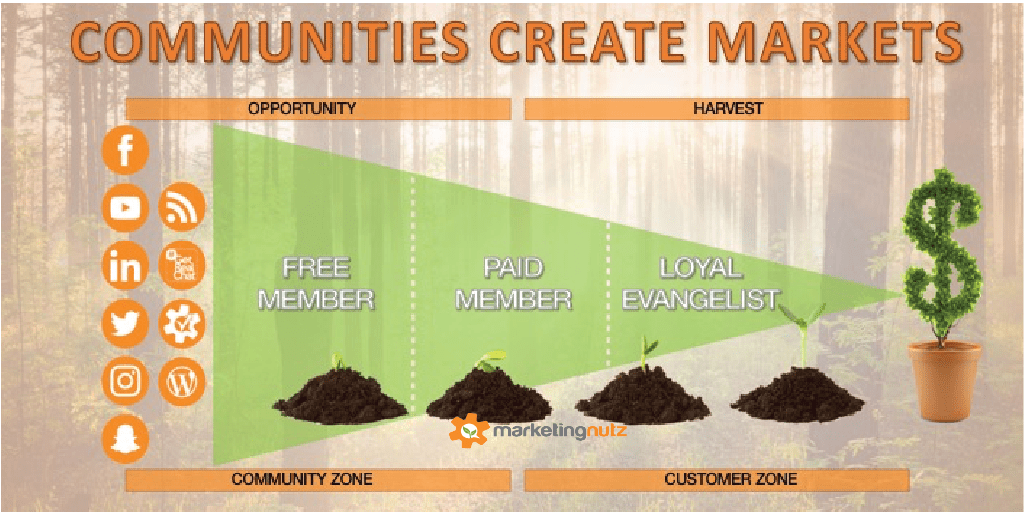Podcast: Play in new window | Download
Did you know that two of the top reasons most businesses fail when it comes to online marketing and social media is lack of planning and impatience.
The heart of digital and social marketing success is community. Social networks, blogs, video channels, and podcasts are about people. People connecting with, serving, laughing and helping other people it what drives the digital web of today.
The true power comes in the form of community.
Communities are not just born overnight via a fast “pop-up” Facebook group with an intent to pursuade people to buy from you. The most powerful communities are nurtured and grown over time, not coerced or bribed.
Planning takes focus and time. Patience is one of the hardest things to have when it comes to building online communities.
The truth is that communities take time. Just like relationships are built on trust that is earned over time, communities are no different. The higher the patience, the greater the end results. Communities are made up of people coming from different backgrounds and education. They have different understandings and expectations what a community is and why they have joined your community.
Earning the trust of community members early on is critical. Community members start out in the “community” or “opportunity” zone and will move to loyal evangelists or paying customers over time, after trust is earned. Moving them from a “free” community member to a “paying” customer takes investment of time, sharing of information and patience.
 Below are a 13 strategies to help community leaders build loyal tribes of evangelists.
Below are a 13 strategies to help community leaders build loyal tribes of evangelists.
1. Be aware of the needs of new community members versus long standing members. New members have different needs than someone who has been a member of your community for a longer period of time. Be sensitive to their need for communication, introduction to other members and help getting acquainted with the norms of the group.
2. Set expectations and guidelines for all members in the community. Keep the guidelines positive but direct enough to provide the needed structure and safety for all.
3. Provide opportunities for members to converse openly. Invite them to special online or offline events. Encourage them to introduce themselves, share their needs from the community as well as what they can offer others.
4. Be available. If you are leading a community, make sure that you are simply available. You don’t need to be available 24/7. However, be available to answer questions, join conversations and help the community learn and grow. Make it clear when you are and are not available by setting proper expectations.
5. Be supportive of organic role development. If people in the community volunteer to take a leadership role for a specific area or task, openly invite, encourage and empower them to do such. Some of the best communities are self governed. If you as the leader of the community are the only one leading, it is likely to become a silo’d dictatorship versus a thriving, healthy community.
6. Be supportive of the OPC (other people’s communities.) One of the greatest benefits of community is the ability for community members to tap into the OPC. There is much power in bringing multiple communities together. Offer structure for these types of dialogs to happen and don’t be afraid you will lose community members by integrating the OPC. Be confident in and know the OPC will help you.
7. Set goals. Know what your goals and objectives are for the community. Take time to understand your audience and community members. Know what you want to get out of the community as well as what members want to achieve.
8. Share your best stuff. When it comes to offering value to the community, don't hold back. Share your best tips, strategies and information you can that will help them. If you do this, others will do the same. A community of value is a community set to grow and succeed.
9. Be patient and acknowledge where in life cycle of community member growth the person is. Don't expect new members to become loyal evangelists overnight. Give them time to build relationships, absorb information, learn, and feel comfortable with you and the other members.
10. Reward good behavior. Acknowledge when community members do really good things. If someone has been helping you with moderation, responding to questions then thank them publicly for such. Same goes for people sharing great information that provides value to others.
11. Offer unique information only available to the community. Don't share the exact same posts to the community group you share on your public tweets, Facebook pages and Pinterest. Instead create unique content only available to members.
12. Inspire your audience to connect with you with a goal of helping them achieve their goals. If you focus on their goals, you will then achieve your goals by default. Inspire – connect – achieve. You can never go wrong by investing in real people.
13. Focus on the heartbeat of social media. The heartbeat of social media is you and me, it's people. Focus on contributing to the healthy heartbeat of your communities as well as others. Don't be the person spamming, trying to get more likes and follows. Instead, offer real value, invest in people. You'll be amazed at the organic results with this small differentiation from what most are doing. Trust me, it works.
Need more help? Social Profit Factor Training Academy Can Help!
Check out our new comprehensive training academy, the Social Profit Factor, that will help with you improve the ROI and business return on all of your social media, digital marketing and branding investment. Sign up now to become a founding member and receive some incredible deals plus bonus offers. Social Profit Factor will teach you how to win at the long game, not just jump in and out for the short one night social stand.

